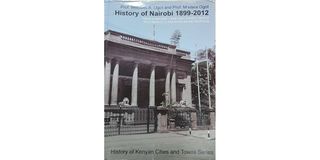Book traces origins of Nairobi, former ‘green city in the sun’

The cover of History of Kenyan Cities and towns Series.
What you need to know:
- Nairobi was once a swamp.
- History of Nairobi 1899-2022 comes after the one on Kisumu, in the ‘History of Kenyan Cities and Towns Series’ that the two authors are writing.
- Africans and Asians provided the labour as well as market for the goods and services.
In many parts of the world, a city worth its name would have a holder or carrier or archivist of its memory. Such an individual keeps and (re-)tells the story.
Nairobi doesn’t seem to entertain such dreams. Once known as the ‘green city in the sun’, for the greenery that defined its swampy life, today Nairobi wallows in dirt, all green spaces having ceded ground to an inchoate jungle of concrete.
Office blocks, apartments, kiosks and all manner of constructions compete to erase jacarandas, loquats, flame trees and acacias, among others.
Nairobi was once a swamp. It was actually an accidental town. The British railway builders sought to establish a camp as they to lay the railway to Uganda. More than 300 miles from Mombasa, they found Nairobi acceptable. But the railway depot had a good clime and there was ample supply of fresh produce from the local communities that traded across one of the rivers crisscrossing the place – the Kikuyu and Maasai. And so the future city began humbly as a mere stopover.
This camp, today an African metropolis, is what Bethwell Ogot and Madara Ogot celebrate in their voluminous new book, History of Nairobi 1899-2022: From a Railway Camp and supply Depot to a World-class African Metropolis (Anyange Press, 2020).
History of Nairobi 1899-2022 comes after the one on Kisumu, in the ‘History of Kenyan Cities and Towns Series’ that the two authors are writing. But this 857-pages volume is the most detailed study or historical account of any Kenyan town.
Precolonial towns
For a country with old, precolonial towns such as Mombasa, Lamu and Malindi, and several urban centres established at the beginning and during colonial rule, it is more than surprising that many of these towns and centres do not have proper records of their existence. History of Nairobi 1899-2022 breaks new grounds on archiving the life and times of our urban centres.
But how does one write a book on Nairobi without attempting to record every facet of its life or without leaving out many interesting aspects of its identity? Does one simply do the chronological take, from the beginning to now (when the book is printed) or does the writer record events, people, places, the environment etc, hoping that the story of the city will somehow form itself?
The authors of History of Nairobi 1899-2022 use multiple methods to write about Nairobi. Which is why they have six major sections.
Even then, keener observers of Nairobi will realise that what is recorded in these pages is simply an invitation to others – writers, archivists, cartographers, town planners, readers etc – to investigate and write more about this former green city in the sun.
Also, these divisions mean one can choose which parts to read, without necessarily having to follow the text chronologically.
Frontier town
The first section looks at the establishment of Nairobi as a railway camp that later became a frontier town, between 1899 and 1920. Here one gets to know how the town was actually established – what were the first buildings; how was the town demarcated; the divisions of settlement areas; the town’s business; who settled here from the beginning; its progression into a municipality; who it served (settlers, workers, visitors such as hunting safaris etc).
Part two of the book deals with its proper colonial history, between 1920 and 1945.
Railway
It details its politics and governance. Remember the building of the railway was being done by a private company – Imperial British East Africa Company. So, how did this commercial venture trigger colonial incursion into what would later become the Kenya colony? The details in this chapter reveal how the relationship between what were deemed private British business interests and the Empire builders created a colony out of the region.
But to run a colony one needed money. To make money and generate revenues for the government, one needed labour and resources to exploit. Africans and Asians provided the labour as well as market for the goods and services. Thus, this section also discusses the economics, politics, the rise of trade unions, city planning, cultural life and such other activities that relate to urbanisation.
The Nairobi of the time was a man’s city as reflected in the words of the then mayor: “Nairobi was established as an English town and it shall remain so. It will never be reduced to a suburb of an Indian city.” His was a response to a charge by an Asian Council Member who had accused the city of racism in employment.
English metropolises
Section three continues to record Nairobi’s life as it becomes a proper city, between 1945 and 1963, modelled along the lines if the English metropolises. What kinds of businesses thrived in Nairobi and who owned them? The mix between politics and trade unionism, and the State of Emergency are discussed here.
This is the period Africans asserted their demands for political inclusion and they got elected to the City Council and later the Legislative Assembly. Here the Ogots record the rise of Nairobi into a proper city, with new estates being built, Africans establishing themselves in business.
If you thought hawking is new to Nairobi, you should know that it was among the first means by which Africans raised capital for business. This sections ends with one of the most significant days in the history of this country, ‘Uhuru celebrations’ on December 12, 1963.
After independence, the years 1964 to 1972 are described as the ‘period of growth and optimism’ in Nairobi and Kenya. Africans are in power. The Africanisation/Kenyanisation programme begins.
Kenya is growing. Its exports are fetching good money on the world market. The East African Community is thriving. However, politics is unravelling. There is tension among the politicians. The national spirit of the pre-independence years is waning.
Political assassinations shadow those who may challenge the status quo – Pinto and Mboya – symbolising a rise of political disorder. Nairobi remains the national capital city and the heart of economic progress. But socio-economic and political divides emerge.
This is why the authors describe the years between 1973 and 1992 as times of ‘political decay and state in crisis’. Again, the Ogots see Nairobi through the lens of its politics, governance, manufacturing, general economy, its emergence as an ‘international centre’, hosting global organisations and events, home to an international airport when JKIA was inaugurated in 1978, among other factors.
This is the Nairobi in which the University of Nairobi was inaugurated on December 30, 1970. But one notes that Nairobi was decaying with garbage all over the city, chaos in the transport sector, lack of housing and rise of unplanned neighbourhoods etc. This is the Nairobi of the gated communities sharing boundaries with slums.
‘Multiparty Democracy and a City on the Mend’ is how the Ogots describe the years between 1992 and 2012. Again, the authors continue to suggest that the life of the city could not be separated from the nation’s politics.
Indeed, the call for multiparty politics and return of democracy were largely made in Nairobi, which is where the battle for the soul of the country have generally been fought.
These battles eventually lead to the opening up of the political landscape. Multiparty elections happen in 1992. Ten years later President Moi retires and the opposition, led by Mwai Kibaki, takes over government.
Global terrorism
The Nairobi of the post-2000s is a city that continues to host global organisations; sees a rise in foreign investments; is globally connected and thus becomes collateral victim of global terrorism pitting Euro-Americans against extremists, mostly from the Middle East and Asia.
This is a Nairobi that is struggling to renew itself despite the growth in informal settlements, rise in population and unemployment. The authors end with a note detailing the end of the City Council of Nairobi and the rise of Nairobi County.
The Nairobi of today is caught between politicians and bureaucrats. One can only wait to see what kind of Nairobi will emerge in the end – an industrialising, clean, working Nairobi wished for by Nairobi Metropolitan Services team, or the ‘life-as-usual’ Nairobi County government-led one, with the congested termini, dirty markets, unplanned buildings etc.
One wishes that leaders of NMS and the county government could get a copy of History of Nairobi 1899-2022: From a Railway Camp and supply Depot to a World-class African Metropolis, to help them think through how to actually keep and grow the city into a real ‘world-class African metropolis’.





